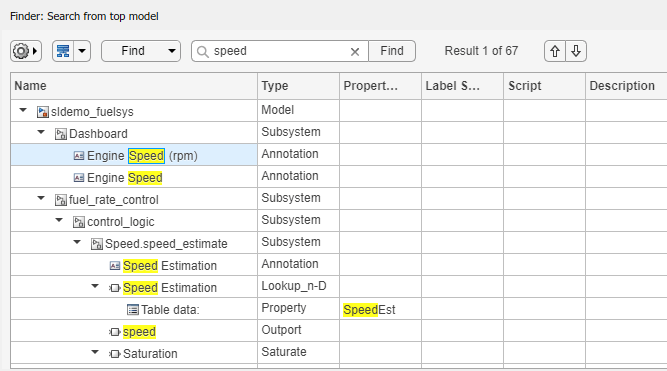Finder
Find and optionally replace values in Simulink models, libraries, and subsystems
Description
Use the Finder to search for Simulink® models, libraries, and subsystems for elements that contain the search string that you enter.
The search can match the string anywhere in the element, such as in the name or in the parameter values. You can customize the search to look only in certain types of elements or for elements with specific parameter settings.
From the search results, you can select and navigate to elements. You can also replace found instances of the search string with another string.
By default, the Finder searches all model elements in the current system, its referenced models, its linked blocks, and its masked systems for case-insensitive partial or full matches.
Open the Finder
In the Simulink Toolstrip, on the Modeling tab, click Find.
In the Simulink quick access toolbar, click Find
 .
.If Find
 is not in the quick access toolbar, click
Common Controls
is not in the quick access toolbar, click
Common Controls
 and select Find.
and select Find.With the Simulink Editor selected, press Ctrl+F.
Limitations
You cannot use the Finder to replace code in a Test Sequence block.
Tips
To select the starting point for your search, use the Model Browser.
To go to and select the element in the model, double-click an item in the list.
To search for any model elements that match the search criteria, enter an asterisk (
*) in the search box.To search for a string that contains a colon, escape the colon using a backslash (for example,
Earth\: a planet), or use single or double quotes around the expression (for example,'Earth: a planet'or"Earth: a planet").You can interact with search results while the search runs. However, you can sort the results only after the search is complete.
To stop a search and view partial search results, in the Finder, click the Stop button.
For table display options, pause on the Name heading and click the arrow that appears. The menu provides options to expand, collapse, and sort results. To sort the table based on another column, pause on the corresponding table heading and click the arrow that appears.
Version History
Introduced in R2016b


